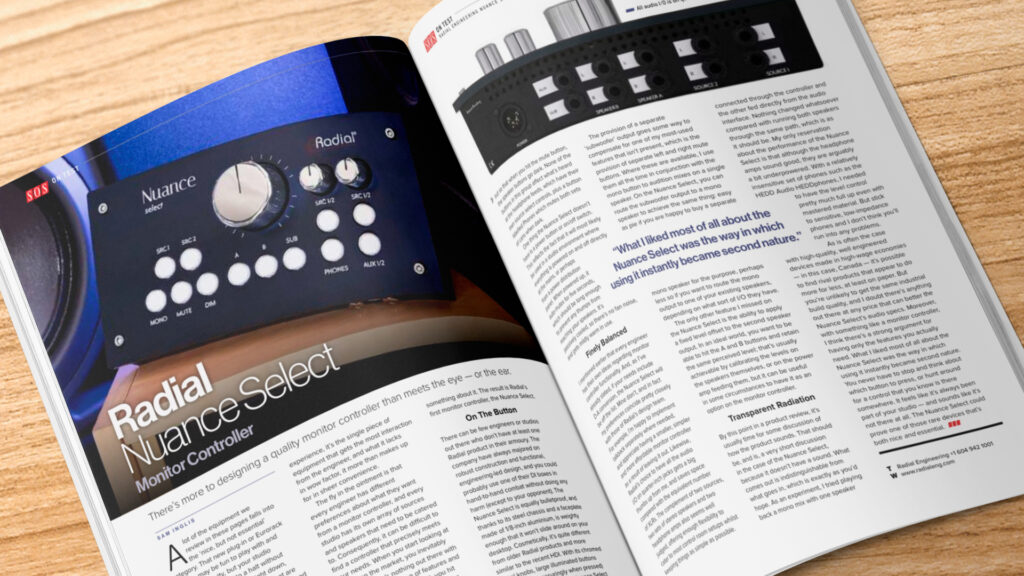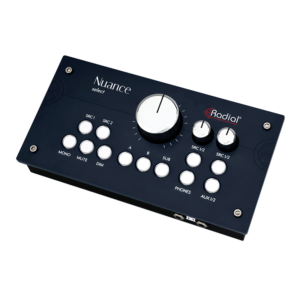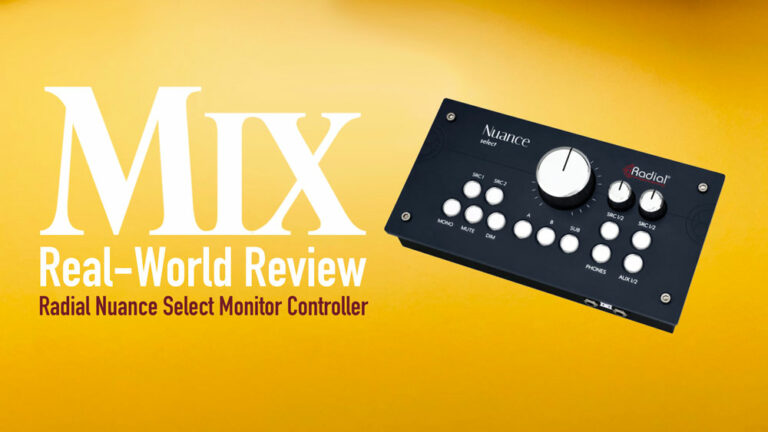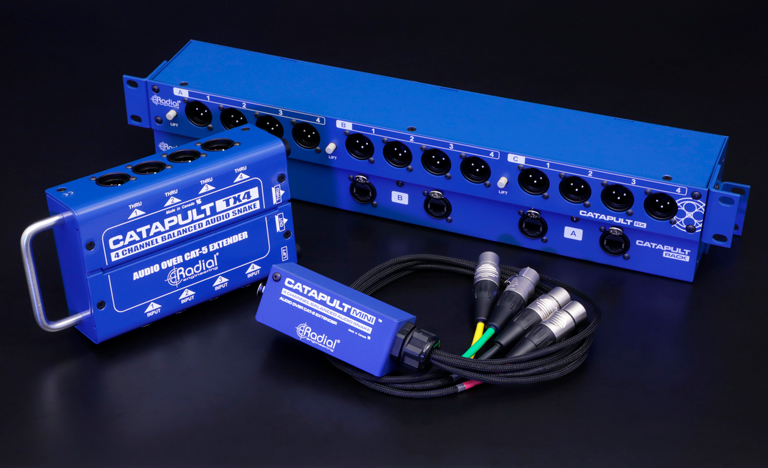The following review by Sam Inglis was originally published in Sound on Sound Magazine.
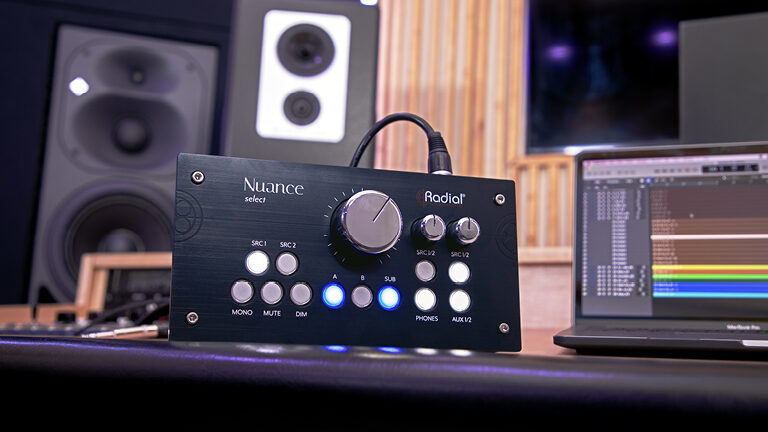
There’s more to designing a quality monitor controller than meets the eye — or the ear.
A lot of the equipment we review in these pages falls into the ‘nice, but not essential’ category. That new plug-in or Eurorack module may be fun to play with and inspire creativity, but your studio isn’t going to grind to a halt without it. And if you boil things right down, there are relatively few items that are absolutely indispensable. Speakers and headphones, for sure; microphones, if you record audio; a computer and an audio interface.
The only reason that list doesn’t include monitor controllers, though, is that most audio interfaces already have some degree of monitor control built in. At a pinch, you can also implement it in software. However, as time goes by, I’ve become increasingly convinced that a good quality, standalone monitor controller is one of the most important investments you can make. In my experience, it’s the single piece of equipment that gets the most interaction from the engineer, and what it lacks in wow factor, it more than makes up for in sheer convenience
The fly in the ointment is that every engineer has different preferences about what they want from a monitor controller, and every studio has its own array of sources and speakers that need to be catered to. Consequently, it can be difficult to find a controller that precisely meets your needs. When you start looking at what’s on the market, you inevitably find that there’s nothing out there with the exact combination of features and I/O you want. Or, worse still, you hit upon something that looks ideal for your purposes, only to discover that it colours the sound in some insidious way.
That, apparently, was the experience of Radial Engineering’s design team — and unlike you or me, they had both the opportunity and the know-how to do something about it. The result is Radial’s first monitor controller, the Nuance Select.
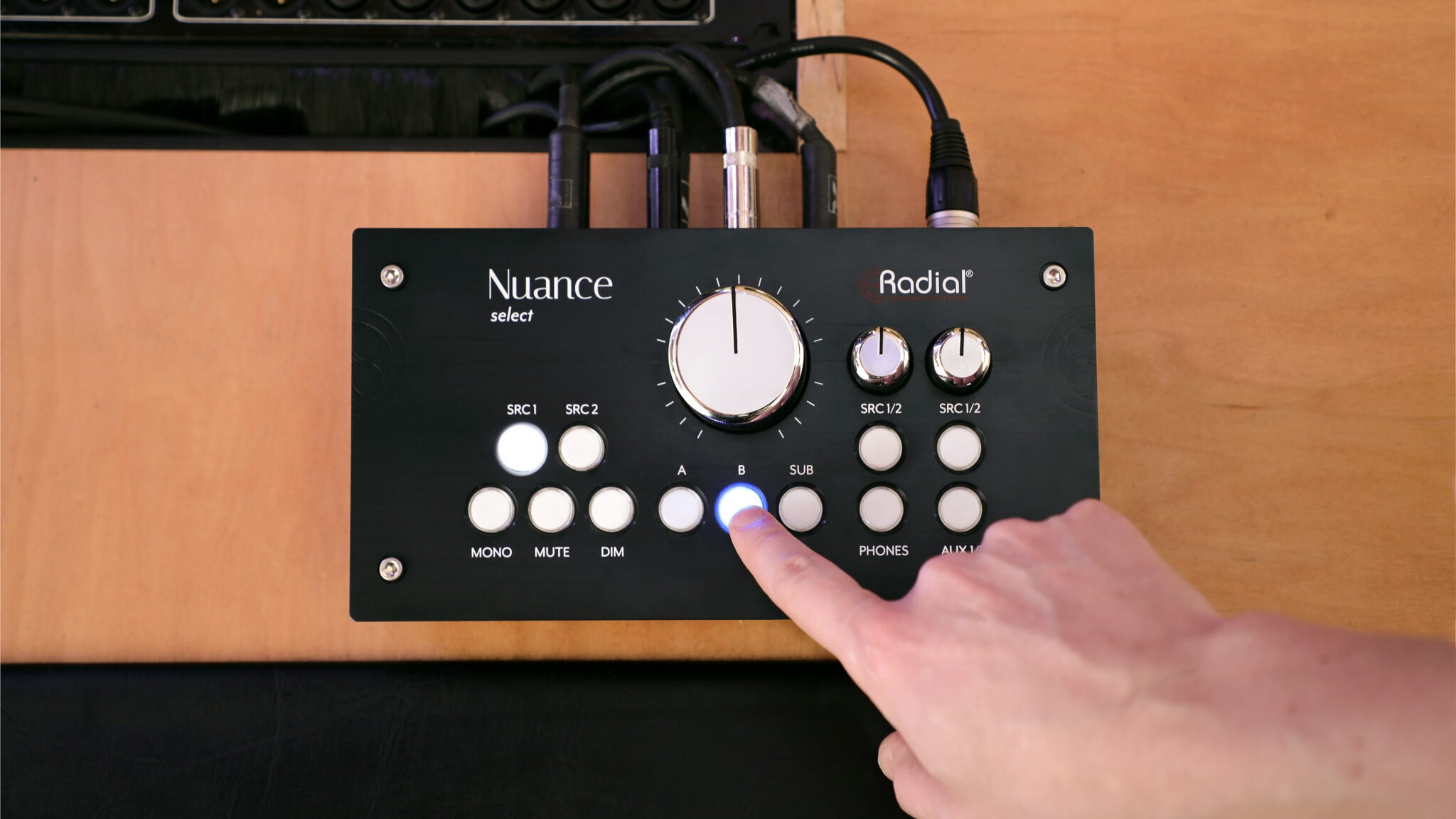
On The Button
There can be few engineers or studios out there who don’t have at least one Radial product in their armoury. The company have always majored on robust construction and functional, engineering-led design, and you could probably use one of their DI boxes in hand-to-hand combat without doing any harm (except to your opponent). The Nuance Select is equally bulletproof, and thanks to its steel chassis and a faceplate made of 1/8-inch aluminium, is weighty enough that it won’t slide around on your desktop. Cosmetically, it’s quite different from older Radial products and more similar to the recent HDI. With its chromed metal knobs, large illuminated buttons (which click reassuringly when pressed) and slick black finish, the Nuance Select is a really good example of industrial design that is simultaneously attractive and ergonomic, allowing the user to take in all the settings at a glance even from a distance.
Many studio monitor controllers these days are also audio interfaces, or at least digital-to-analogue converters. Not so the Nuance Select, which is a purely analogue device. It’s an active controller, powered by an external laptop-style supply that connects securely using a four-pin XLR. Radial say that the Nuance Select uses a “unique patent-pending circuit design” that operates in Class A throughout and has no capacitors in the signal path. This enables it to achieve remarkable audio specifications, including a THD figure of below 0.00001 percent — that’s an astonishing -140dB.
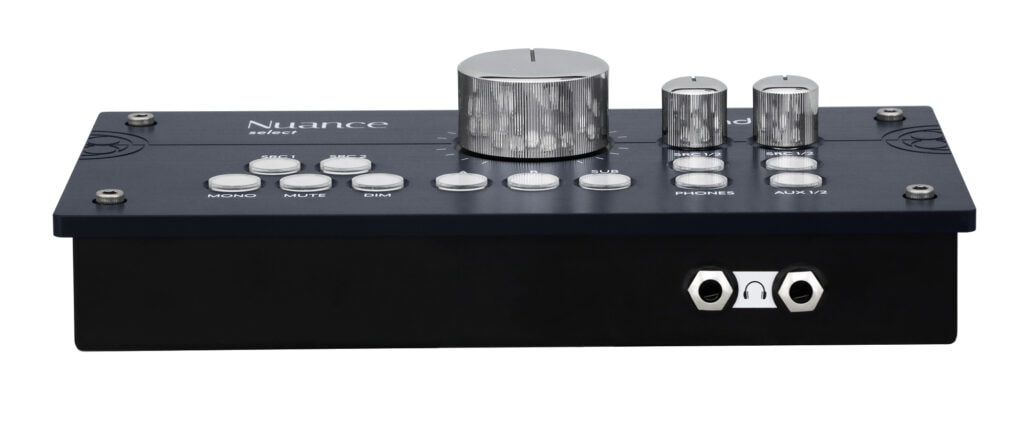
New Jack City
Audio socketry is all on quarter-inch jacks, with two sources entering on balanced pairs, and two more balanced output pairs for the connection of main and alternate speakers. Two further TRS jacks provide additional outputs: one an unbalanced auxiliary stereo feed for a meter or an external headphone amp, and the other a balanced mono feed intended for a subwoofer or mono speaker. Finally, the Nuance Select is also a headphone amp in its own right, with two phones sockets on the front panel. These can be switched independently to pick up either of the two sources, and have separate volume controls.
Both the headphone level controls and the main volume control are stepped, and the latter is said to offer gain matching of better than 0.1dB in all of its 21 positions. This seemed a sensible number to me, combining enough granularity for most purposes with sufficiently discrete stepping to make it easy to recall settings by eye. Maximum volume equates to unity gain from source to speaker output, as you’d expect. The auxiliary output bypasses the volume control and, being unbalanced, drops the signal level by 6dB compared to the source.
Unlike some monitor controllers, the Nuance Select does not allow multiple sources or speakers to be selected at once, so for example pressing the SRC 2 button automatically deselects SRC 1 and vice versa. The exception to this is the subwoofer output, which is switched independently of the A and B speaker outputs. All are full-range, so any bass management needs to be handled elsewhere in the chain. Located below the source select buttons are mono, mute and -15dB dim buttons, and the switch logic behind the LEDs is nicely thought out so that when you hit the mute button, the speaker buttons go dark. None of the buttons in this group affect what’s heard at the headphone feeds, which have their own source select controls, plus a button labelled Phones which mutes both sets of cans when dark.
One thing the Nuance Select doesn’t have is a power button or on/off switch. This reflects the fact that it will most likely be used in a studio environment where everything is powered on and off directly at the mains, or perhaps from a power distribution panel. When powered up, it auto-mutes for five seconds, which should be long enough to prevent any thumps from reaching your speakers. It’s passively cooled, so there’s no fan noise, and gets mildly warm in use.
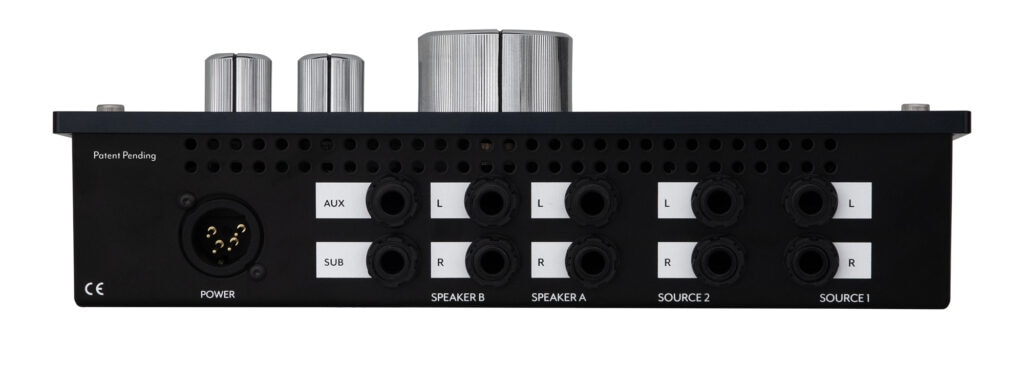
Finely Balanced
I mentioned earlier that every engineer has their own ideas regarding monitor controller functionality. And, as I’ve already stated, if your needs include D-A conversion, the Nuance Select will be off the list. Mine don’t, and in fact my preferences coincide pretty closely with those of Radial’s design team. For example, I’m happy to implement talkback separately where needed, and appreciate having a smaller, simpler and more affordable monitor controller as a result of leaving it out. Likewise, Radial’s choice to have all the audio I/O on quarter-inch jacks gets a big thumbs up from me, and saves space compared with the equivalent number of XLRs. The complement of two sources, two sets of stereo speakers and two headphone amps also seems well judged, offering enough flexibility to cater to most control room setups whilst keeping things as simple as possible.
The provision of a separate ‘subwoofer’ output goes some way to compensate for one of my most-used features that isn’t present, which is the provision of separate left and right mute buttons. Where these are available, I use them all the time in conjunction with the mono button to audition mixes on a single speaker. On the Nuance Select, you can route the subwoofer output to a mono speaker to achieve the same thing: easy as pie if you are happy to buy a separate mono speaker for the purpose, perhaps less so if you want to route the mono output to one of your existing speakers, depending on what sort of I/O they have.
The only other feature I missed on the Nuance Select is the ability to apply a fixed level offset to the second speaker output. In an ideal world, you want to be able to hit the A and B buttons and retain the same perceived level; that’s usually achievable by calibrating the levels on the speakers themselves, or on the power amp feeding them, but it can be useful in some circumstances to have it as an option on the monitor controller.
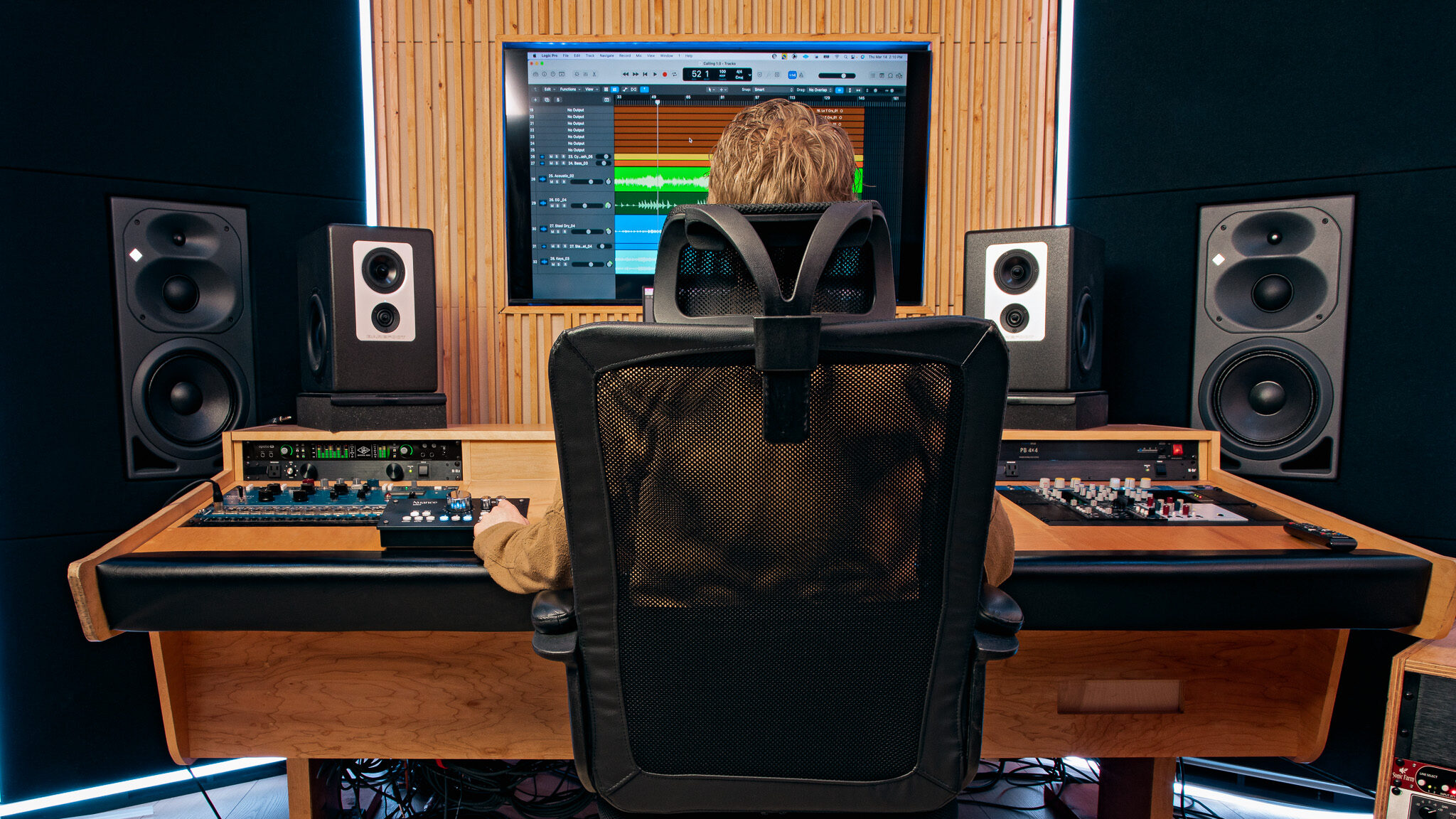
Transparent Radiation
By this point in a product review, it’s usually time for some discussion of how the product sounds. That should be, and is, a very short discussion in the case of the Nuance Select, because it doesn’t have a sound. What comes out is indistinguishable from what goes in, which is exactly as you’d hope. As an experiment, I tried playing back a mono mix with one speaker connected through the controller and the other fed directly from the audio interface. Nothing changed whatsoever compared with running both speakers through the same path, which is as it should be. My only reservation about the performance of the Nuance Select is that although the headphone amps sound good, they are arguably a bit underpowered. With a relatively insensitive set of phones such as the HEDD Audio HEDDphones, I needed to have the level control pretty much full up even with mastered material. But stick to sensitive, low-impedance phones and I don’t think you’ll run into any problems.
As is often the case with high-quality, well engineered devices made in high-wage economies — in this case, Canada — it’s possible to find rival products that appear to do more for less, at least on paper. But you’re unlikely to get the same industrial build quality, and I doubt there’s anything out there at any price that can better the Nuance Select’s audio specs. Moreover, with something like a monitor controller, I think there’s a strong argument for having only the features you actually need. What I liked most of all about the Nuance Select was the way in which using it instantly became second nature. You never have to stop and think about which button to press, or hunt around for a control that you know is there somewhere. It feels like it’s always been part of your studio — and sounds like it’s not there at all. The Nuance Select could prove one of those rare devices that’s both nice and essential.

| RADIAL NUANCE SELECT |
| PROS – Transparent sound with superb audio specifications – Excellent build quality and ergonomics – Well‑judged feature set |
| CONS – Headphone amps may not be powerful enough for everyone |
| SUMMARY Radial’s all-analogue monitor controller is built like a tank, sonically colourless and a pleasure to use. |



